Abstract
When work load on the respiratory system is increased the relative increase in blood flow to each of the muscles of breathing provides an index of how the augmented effort of breathing is partitioned among the different muscles. We have used a radio-active microsphere technique to measure blood flow to each of the muscles of respiration in supine dogs during unobstructed respiration and breathing against graded expiratory threshold loads. 79% of the augmented flow went to expiratory muscles; of this increased flow to expiratory muscles 74% went to abdominal wall muscles and 26% to internal intercostals. In our earlier studies of hyperventilation induced by CO2 rebreathing where expiratory work loads were low, 44% of the increase in flow went to expiratory muscles; of this, only 39% went to abdominal wall muscles and 61% to internal intercostals. During inspiratory resistance which produced small increases in expiratory work, 27% of the increase in blood flow went to expiratory muscles; of this, only 37% went to abdominal wall muscles and 63% to internal intercostals. These results suggest that the internal intercostals are predominantly used for expiration when expiratory work loads are low, whereas the abdominal wall muscles are predominantly used when loads are high.
For similar rates of pressure-volume work done on the lung, the total respiratory muscle blood flow is significantly greater during expiratory loads than during unobstructed hyperventilation or inspiratory loads. Thus, the abdominal wall muscles that are utilized for overcoming high pressure expiratory loads are relatively inefficient in converting metabolic energy into pressure-volume work.
Full text
PDF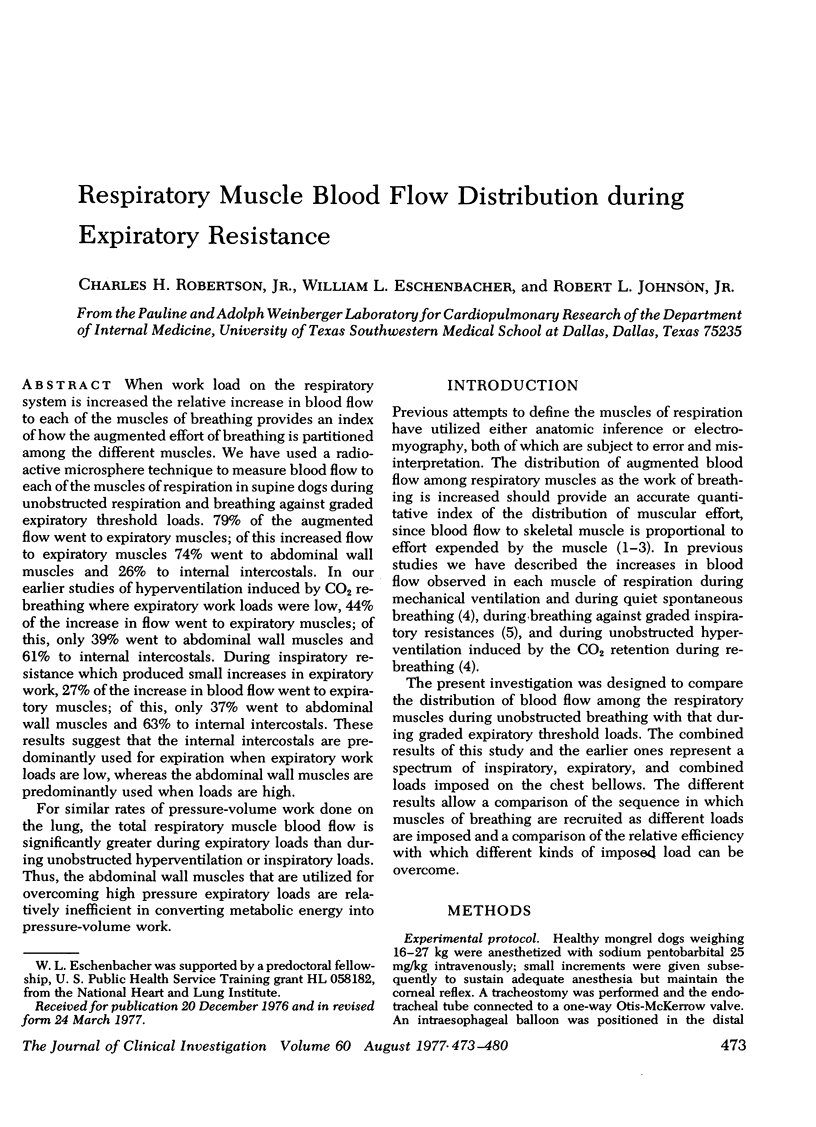
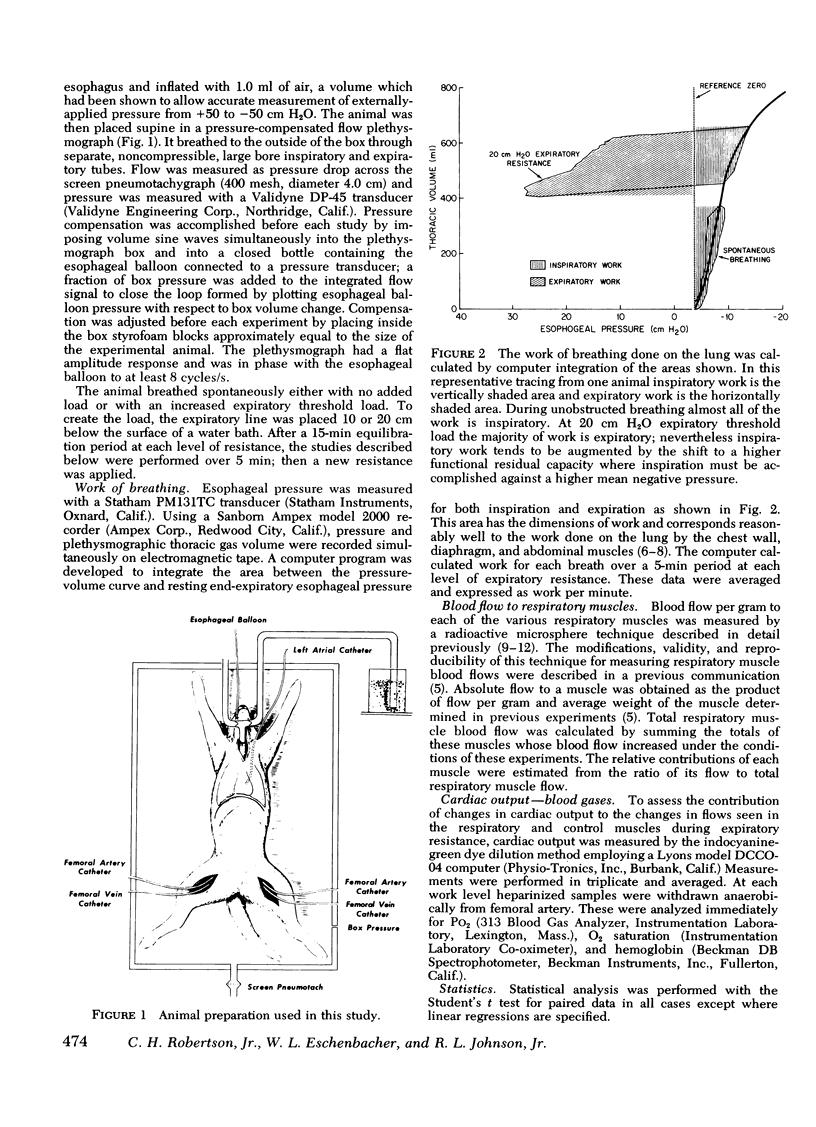
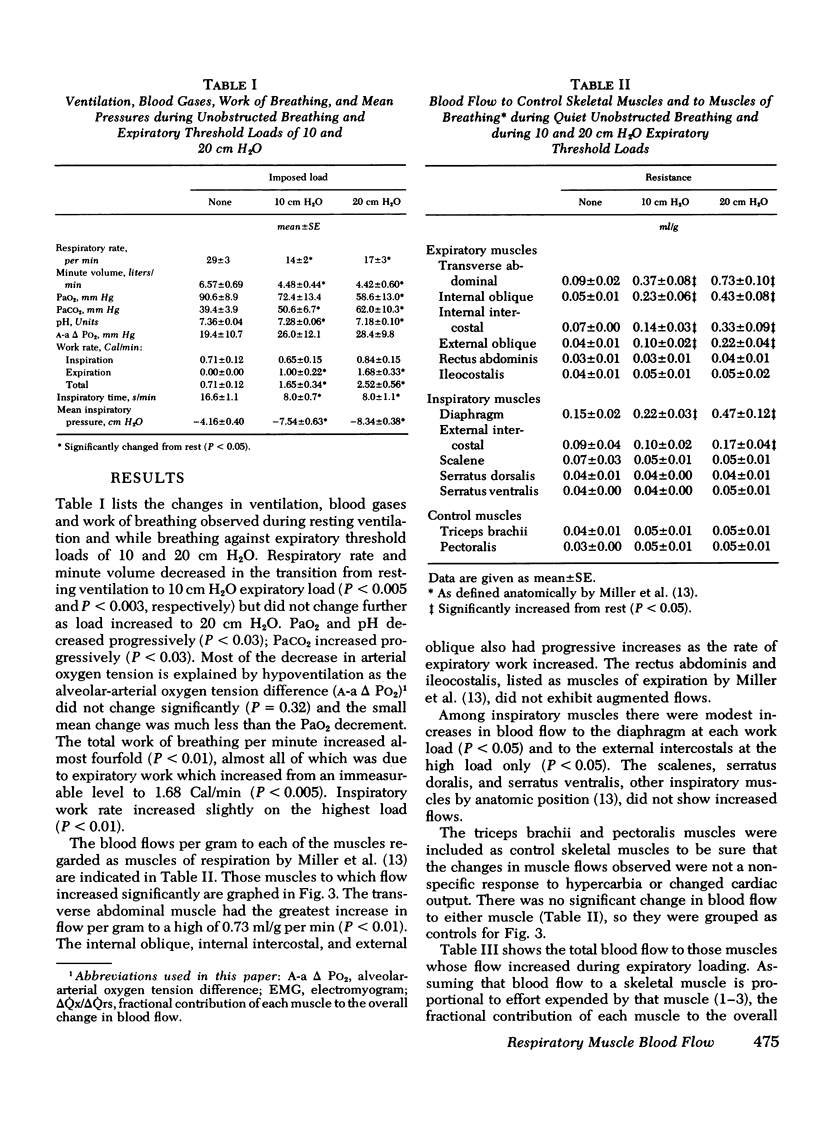
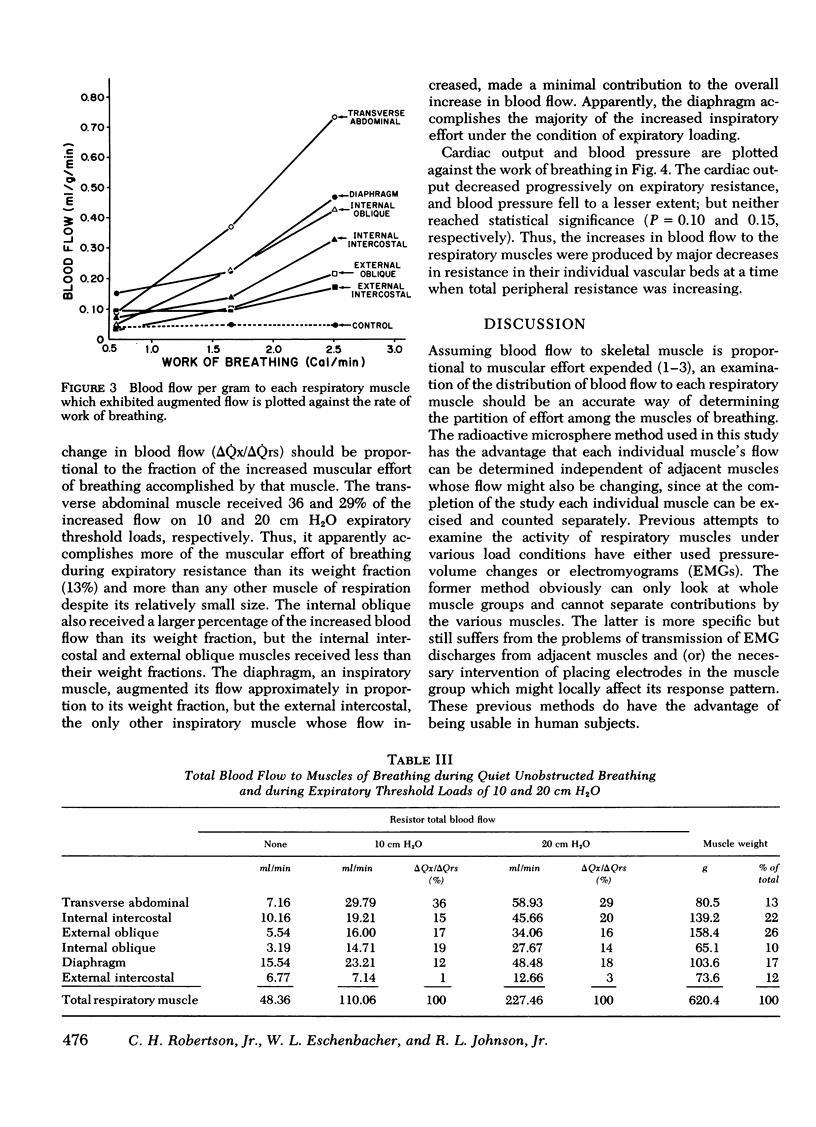


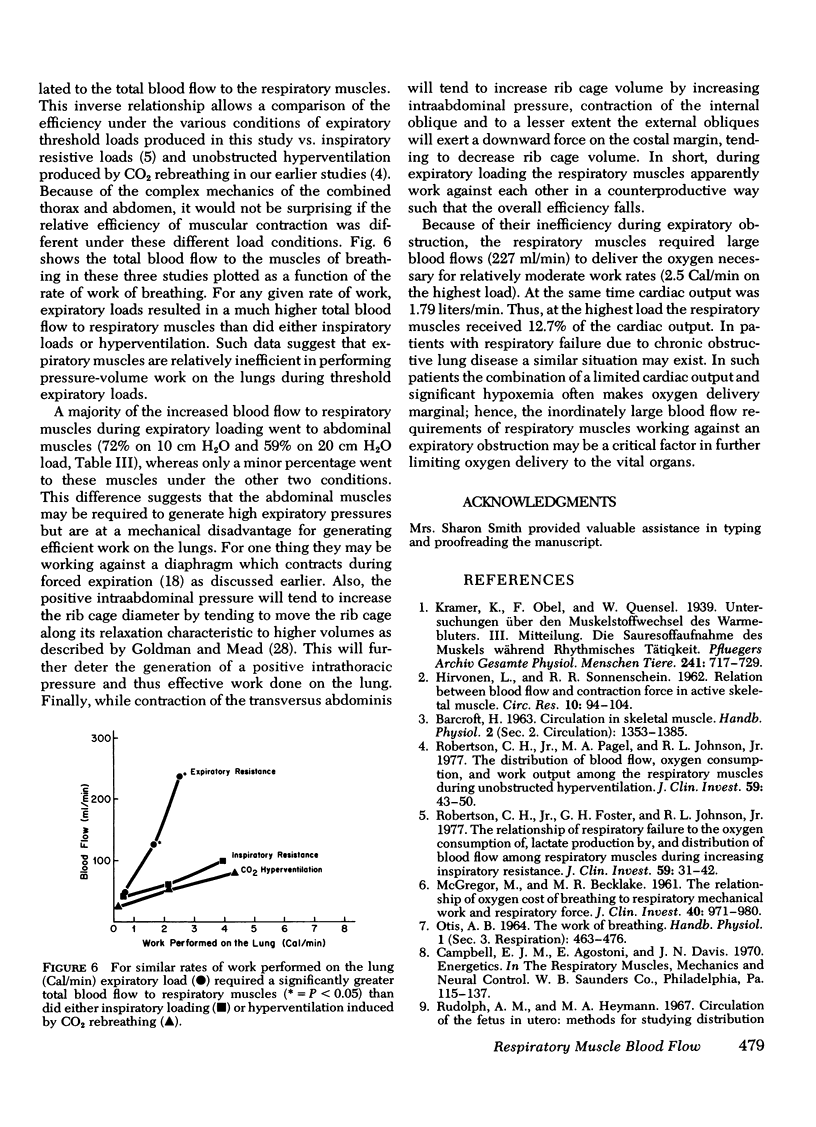

Selected References
These references are in PubMed. This may not be the complete list of references from this article.
- AGOSTONI E., RAHN H. Abdominal and thoracic pressures at different lung volumes. J Appl Physiol. 1960 Nov;15:1087–1092. doi: 10.1152/jappl.1960.15.6.1087. [DOI] [PubMed] [Google Scholar]
- AGOSTONI E., SANT'AMBROGIO G., DEL PORTILLO CARRASCO H. Electromyography of the diaphragm in man and transdiaphragmatic pressure. J Appl Physiol. 1960 Nov;15:1093–1097. doi: 10.1152/jappl.1960.15.6.1093. [DOI] [PubMed] [Google Scholar]
- Agostoni E., Gurtner G., Torri G., Rahn H. Respiratory mechanics during submersion and negative-pressure breathing. J Appl Physiol. 1966 Jan;21(1):251–258. doi: 10.1152/jappl.1966.21.1.251. [DOI] [PubMed] [Google Scholar]
- Archie J. P., Jr, Fixler D. E., Ullyot D. J., Hoffman J. I., Utley J. R., Carlson E. L. Measurement of cardiac output with and organ trapping of radioactive microspheres. J Appl Physiol. 1973 Jul;35(1):148–154. doi: 10.1152/jappl.1973.35.1.148. [DOI] [PubMed] [Google Scholar]
- Bishop B., Bachofen H. Vagal control of ventilation and respiratory muscles during elevated pressures in the cat. J Appl Physiol. 1972 Jan;32(1):103–112. doi: 10.1152/jappl.1972.32.1.103. [DOI] [PubMed] [Google Scholar]
- Bishop B. Diaphragm and abdominal muscle responses to elevated airway pressures in the cat. J Appl Physiol. 1967 May;22(5):959–965. doi: 10.1152/jappl.1967.22.5.959. [DOI] [PubMed] [Google Scholar]
- Buckberg G. D., Luck J. C., Payne D. B., Hoffman J. I., Archie J. P., Fixler D. E. Some sources of error in measuring regional blood flow with radioactive microspheres. J Appl Physiol. 1971 Oct;31(4):598–604. doi: 10.1152/jappl.1971.31.4.598. [DOI] [PubMed] [Google Scholar]
- CAMPBELL E. J. M., GREEN J. H. The expiratory function of the abdominal muscles in man; an electromyographic study. J Physiol. 1953 May 28;120(3):409–418. doi: 10.1113/jphysiol.1953.sp004903. [DOI] [PMC free article] [PubMed] [Google Scholar]
- CAMPBELL E. J., DICKINSON C. J., DINNICK O. P., HOWELL J. B. The immediate effects of threshold loads on the breathing of men and dogs. Clin Sci. 1961 Dec;21:309–320. [PubMed] [Google Scholar]
- CAMPBELL E. J. The effects of increased resistance to expiration on the respiratory behaviour of the abdominal muscles and intra-abdominal pressure. J Physiol. 1957 May 23;136(3):556–562. doi: 10.1113/jphysiol.1957.sp005780. [DOI] [PMC free article] [PubMed] [Google Scholar]
- FREUND F., ROOS A., DOOD R. B. EXPIRATORY ACTIVITY OF THE ABDOMINAL MUSCLES IN MAN DURING GENERAL ANESTHESIA. J Appl Physiol. 1964 Jul;19:693–697. doi: 10.1152/jappl.1964.19.4.693. [DOI] [PubMed] [Google Scholar]
- Forsyth R. P., Hoffbrand B. I., Melmon K. L. Redistribution of cardiac output during hemorrhage in the unanesthetized monkey. Circ Res. 1970 Sep;27(3):311–320. doi: 10.1161/01.res.27.3.311. [DOI] [PubMed] [Google Scholar]
- Goldman M. D., Mead J. Mechanical interaction between the diaphragm and rib cage. J Appl Physiol. 1973 Aug;35(2):197–204. doi: 10.1152/jappl.1973.35.2.197. [DOI] [PubMed] [Google Scholar]
- HIRVONEN L., SONNENSCHEIN R. R. Relation between blood flow and contraction force in active skeletal muscle. Circ Res. 1962 Jan;10:94–104. doi: 10.1161/01.res.10.1.94. [DOI] [PubMed] [Google Scholar]
- JONES D. S., BEARGIE R. J., PAULEY J. E. An electromyographic study of some muscles on costal respiration in man. Anat Rec. 1953 Sep;117(1):17–24. doi: 10.1002/ar.1091170103. [DOI] [PubMed] [Google Scholar]
- Kontos H. A., Thames M. D., Lombana A., Watlington C. O., Jessee F., Jr Vasodilator effects of local hypercapnic acidosis in dog skeletal muscle. Am J Physiol. 1971 Jun;220(6):1569–1572. doi: 10.1152/ajplegacy.1971.220.6.1569. [DOI] [PubMed] [Google Scholar]
- LENFANT C., HOWELL B. J. Cardiovascular adjustments in dogs during continuous pressure breathing. J Appl Physiol. 1960 May;15:425–428. doi: 10.1152/jappl.1960.15.3.425. [DOI] [PubMed] [Google Scholar]
- MCGREGOR M., BECKLAKE M. R. The relationship of oxygen cost of breathing to respiratory mechanical work and respiratory force. J Clin Invest. 1961 Jun;40:971–980. doi: 10.1172/JCI104336. [DOI] [PMC free article] [PubMed] [Google Scholar]
- Robertson C. H., Jr, Foster G. H., Johnson R. L., Jr The relationship of respiratory failure to the oxygen consumption of, lactate production by, and distribution of blood flow among respiratory muscles during increasing inspiratory resistance. J Clin Invest. 1977 Jan;59(1):31–42. doi: 10.1172/JCI108619. [DOI] [PMC free article] [PubMed] [Google Scholar]
- Robertson C. H., Jr, Pagel M. A., Johnson R. L., Jr The distribution of blood flow, oxygen consumption, and work output among the respiratory muscles during unobstructed hyperventilation. J Clin Invest. 1977 Jan;59(1):43–50. doi: 10.1172/JCI108620. [DOI] [PMC free article] [PubMed] [Google Scholar]
- Rudolph A. M., Heymann M. A. The circulation of the fetus in utero. Methods for studying distribution of blood flow, cardiac output and organ blood flow. Circ Res. 1967 Aug;21(2):163–184. doi: 10.1161/01.res.21.2.163. [DOI] [PubMed] [Google Scholar]
- TOKIZANE T., KAWAMATA K., TOKIZANE H. Electromyographic studies on the human respiratory muscles; studies on the activity pattern of neuromuscular units. Jpn J Physiol. 1952 Feb;2(3):232–247. doi: 10.2170/jjphysiol.2.232. [DOI] [PubMed] [Google Scholar]


